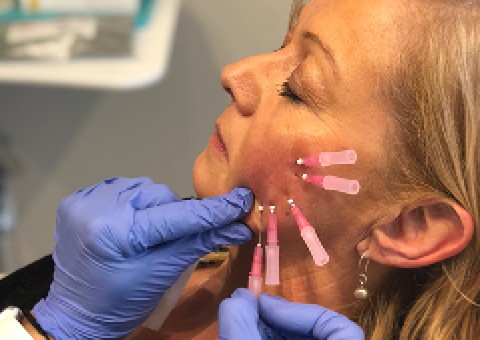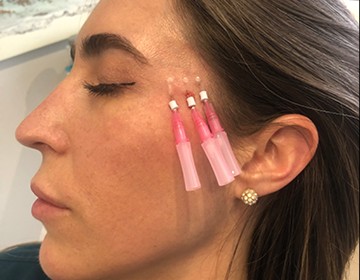
If you search for “PDO threads” online you will get seemingly endless amounts of information about the topic and, interestingly, most if it is centered around the “lifting threads.” Though this type of thread is great and can achieve some targeted results on areas of the face, neck and body, it is also worth discussing some of the other types of threads available that have unique uses and allow providers to be creative in their aesthetic treatment plans. These include smooth threads and twisted threads. Let’s talk about the various purposes and uses of PDO threads!
What Are PDO Threads?
PDO is short for Polydioxanone and this material has been used in medicine for almost 40 years. It is considered one of the safest implants for the body. If you have ever had surgery or any other procedure that required “dissolvable stitches” you have likely already had this compound in your body. A PDO thread is a synthetic, absorbable monofilament that will take about 4-6 months to be completely absorbed by your body and slowly eliminated through your kidneys. During that process, the threads will help stimulate new collagen and elastin in your skin. I like to describe collagen and elastin as a scaffolding-like support structure under your skin,* giving it the strength it needs to combat fine lines and sagging. This support can visibly last 12 to 16 months. PDO threads also help stimulate micro-circulation, muscle relaxation, and increase tissue integrity and volume.

PDO Lifting Threads
Lifting threads have either barbs or cones along the thread that are intended to reposition the overlying skin. These threads are placed in the subcutaneous layer (fat) then pulled so that both the fatty layer and the skin look slightly lifted. While the main intention of barbed threads are to lift, they also stimulate the body to generate new collagen simultaneously. The ideal patient for lifting threads have good skin quality and mild to moderate sagging. For instance, if a patient presented with mild Nasolabial folds, or marionette lines, and with healthy skin they would be an ideal candidate for lifting threads.
PDO Smooth Threads
PDO smooth (and twist) threads do not have barbs and easily glide under the skin in treatment areas for a practically painless insertion. They are a single filament thread designed to stimulate collagen and support the skin, rather than immediately lift or reposition the skin. We recommend coming in every 4-6 weeks for a total of 3-5 treatment sessions when targeting a specific area. Some of these areas can include your crows feet, lines down the cheeks or sides of face, frown lines or Glabella, and Nasolabial folds. A great real-life example of when to use PDO threads is for the patient who has a deep crevice in between their eyebrows that will improve with Botox but likely will not totally fade.
PDO Twist Threads
The unique, coiled shape of PDO twist threads give them greater surface area when compared to other types of threads and therefore produce more dramatic results and collagen production. The flip side is that they do require more finesse when placing them in the skin leading to slightly longer treatment times and more potential for discomfort, but an experienced provider will know how to maximize your comfort and adjust for these considerations if need be. A fantastic application for PDO twist threads is on the lip border to add definition and volume. Other areas of the body such as arms, legs (knees), and stomach can be done as well to help with skin laxity and sagging. They are also great for acne scars!

Why Should I Get PDO Threads?
Many of my colleagues have experienced being treated with PDO threads. Kim, our esthetician, had a few placed in her necklace lines which are the horizontal lines that form around the neck. Megan, one of our NP’s, had a few placed in her temples to help create more volume in that area of her face. Most, if not all, of our patients have reported a positive experience and outcome. When compared to dermal filler, there are a few key differences in PDO threads; they are hydrophobic so there is less chance of attracting fluid (swelling), they work on different planes or levels of the dermis, and there are generally fewer potential side-effects. Of course, PDO threads and filler have different, nuanced applications so they can absolutely be done simultaneously!
A common way to incorporate threads in to your routine would be to add them at the end of your next Botox appointment. Ask your provider about them at your next visit!

